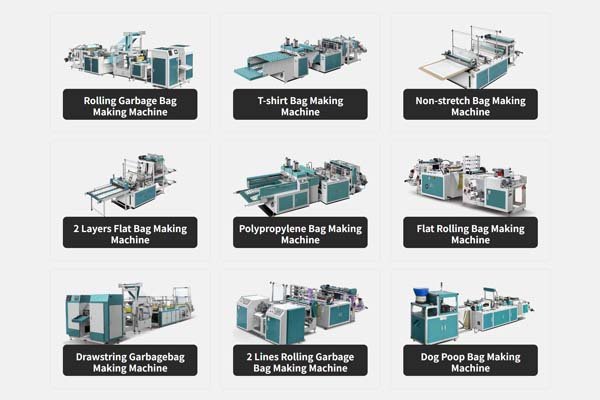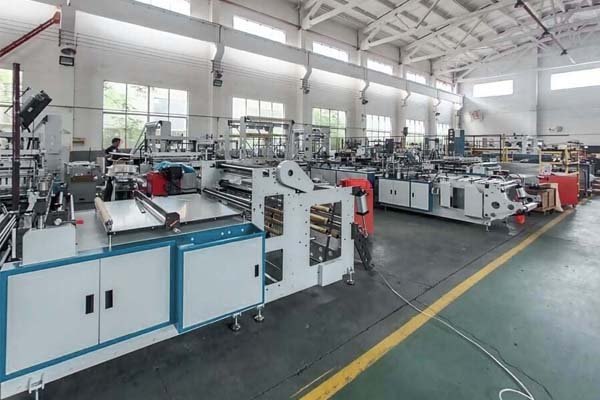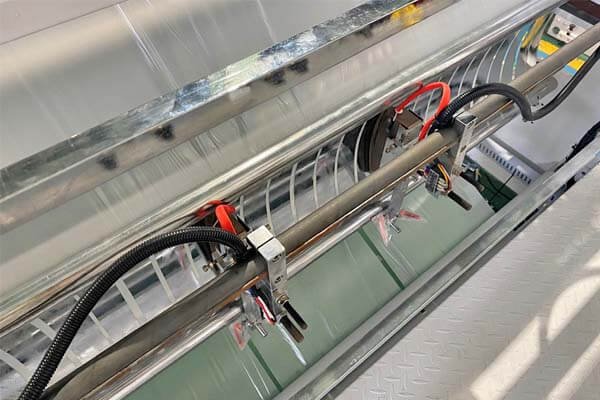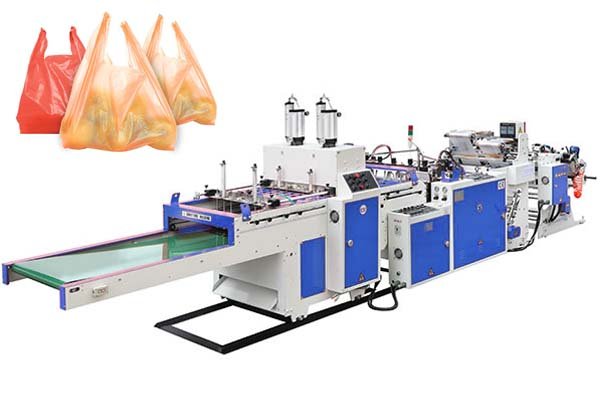
Are you struggling with slow and inconsistent bag production? This inefficiency costs you time and hurts your bottom line. The solution is using a specialized machine designed for high-speed, reliable output.
The equipment used to make plastic bags is called a bag making machine1. The specific type depends on the bag's design, with common models including bottom seal machines, side seal machines, T-shirt bag machines, and heavy-duty machines for industrial use.
At BagMec®, we have specialized in building these machines since 2017. Our machines are designed to take a large roll of plastic film and transform it into finished bags. The process is fully automated. The machine feeds the film, applies heat to create strong seals, and then cuts each bag to the perfect size. This high level of automation is what allows businesses to produce thousands of bags per hour with consistent quality. We focus on engineering our machines for maximum efficiency and durability, using technologies like our "Smart Tension Control2" to ensure a flawless production run every time.
This process looks simple, but each step is carefully engineered. First, the film unwinding must be perfectly smooth. Our systems prevent tearing or stretching. Next, the sealing temperature and pressure must be exact to create seals that are strong but not brittle. This is critical for everything from grocery bags to medical packaging. Finally, the cutting mechanism uses high-carbon steel blades for clean, precise cuts, bag after bag. This attention to detail defines the quality of the final product and the reliability of the machine.
How Does a Plastic Bag Making Machine Work?
Have you ever wondered about the technology inside our machines? It's a precise, automated process. Let's look at how we turn a simple roll of film into a finished product for your customers.
A plastic bag making machine works in three main stages. First, the machine unwinds a roll of plastic film and feeds it into the system. Second, a heated bar melts and presses the film to create the seams. Third, a blade cuts the sealed film to separate each bag.

The Core Manufacturing Process
The three core steps—feeding, sealing, and cutting—are the foundation of all bag production. However, the quality of the final bag depends entirely on how well each step is controlled. At BagMec®, we have integrated advanced technology to optimize this process.
Step 1: Film Feeding and Tension Control
The process starts when a large roll of film (like LDPE, HDPE, or biodegradable PLA) is mounted on the machine. Rollers pull the film into the system.
- The Challenge: If the film is pulled too tightly, it can stretch and deform. If it is too loose, it can wrinkle and cause jams. Both issues lead to wasted material and production downtime.
- Our Solution: We use our patented "Smart Tension Control" system. This technology uses sensors to automatically adjust the roller speed and pressure. It keeps the film perfectly flat and aligned, ensuring a smooth and consistent feed from start to finish. This is especially important when working with thin or delicate films.
Step 2: Sealing and Gusseting
This is where the bag takes its shape. A hot sealing bar presses onto the film. The heat and pressure melt the plastic layers together, forming a permanent bond.
- Bottom Seal: A single sealing bar creates a strong seal along the bottom of the bag. This is ideal for garbage bags or produce bags that need to hold weight.
- Side Seal: Two sealing bars create seams along the sides of the bag. This is common for bread bags, courier bags, or packaging for smaller items.
- Gusseting: For bags that need to hold more volume, like shopping bags, the machine can also create a gusset. This is a fold tucked into the side of the bag that expands when filled.
Our machines use precise temperature controllers and pressure regulators. This ensures that every seal is strong and leak-proof, which is critical for food packaging and industrial applications.
Step 3: Cutting, Stacking, and Automation
Once the bag is sealed, it is cut from the film roll.
- The Technology: We use energy-saving servo motors to drive the cutting blade. This allows for extremely fast and precise cuts, with a tolerance of less than a millimeter. The result is perfectly uniform bags, every single time.
- Stacking: After cutting, the finished bags are automatically stacked on a collection table. Some of our advanced models can count the bags and bundle them into set quantities, ready for packing and shipping. This level of automation reduces labor costs and speeds up the entire production line.
| Process Stage | Key Components | The BagMec® Advantage |
|---|---|---|
| Feeding | Unwind Stand, Rollers, Dancers | "Smart Tension Control" for waste reduction |
| Sealing | Heated Sealing Bar, Silicone Pad | Precision temperature control for strong, reliable seals |
| Cutting | Cutting Blade, Servo Motor | High-speed servo motor for ±1mm cutting accuracy |
| Control | PLC System, Touchscreen UI | User-friendly interface (multi-language available) |
What Are the Different Types of Bag Making Machines?
Not all bags are the same, so the machines that make them must also be different. We design and build a wide range of machines to meet the specific needs of different industries and products.
We manufacture numerous machine types, including T-Shirt Bag Machines for retail, Side Sealing Machines for flat pouches, Heavy-Duty Bag Machines for thick garbage bags, and specialized models like our Wicketer Bread Bag and Lamination Pouch machines for specific markets.

Matching the Machine to the Bag
Choosing the right machine is the most important step for a packaging business. Each of our models is engineered for a specific purpose, material, and production speed.
For Retail and Shopping
- T-Shirt Bag Making Machine3: This is one of our most popular models. It automatically creates the bag, punches out the handles, and stacks them for easy use in supermarkets and retail stores. It works at high speeds to meet mass-market demand.
- Loop Handle Bag Making Machine: This machine creates more premium shopping bags. It attaches separate, soft plastic loops as handles, offering a more comfortable and durable carrying experience.
- Patch Handle Bag Making Machine: This machine reinforces the handle area with an extra "patch" of plastic before punching the handle. This makes the bag stronger and is common for boutique and high-end retail bags.
For Food and Hygiene
- Food Package Bag Machine: These machines are built with food-grade materials and designed for easy cleaning to meet FDA standards. They often include features like zipper insertion for resealable pouches.
- Wicketer Bread Bag Machine: This is a high-speed, specialty machine. It produces bags held on a "wicket"—a set of metal pins. This design allows bakeries to use automated equipment to quickly package bread and other baked goods.
- Diaper Bag Making Machine: Built for the hygiene industry, these machines create high-quality bags for packaging diapers. They are designed for aseptic production environments to ensure product safety and cleanliness.
For Industrial and Logistics
- Heavy-Duty & Garbage Bag Machine: These machines are built to handle thick, strong plastic films. They use a strong bottom seal to produce bags that can carry heavy loads without breaking, perfect for construction waste or large trash cans.
- Courier Bag Making Machine: A key machine for the e-commerce industry. It produces tough, tear-resistant bags with a permanent adhesive strip. Our models can also integrate QR code printers for logistics tracking.
- FFS (Form-Fill-Seal) Bag Machine: This advanced machine forms the bag, fills it with a product (like snacks or powders), and seals it shut, all in one continuous process. It is a complete packaging solution for high-volume producers.
| Machine Type | Common Application | Key Feature | BagMec® Price Range (USD) |
|---|---|---|---|
| T-Shirt Bag Machine | Supermarkets, Retail | High speed, integrated handle punch | $17,000 – $32,000 |
| Side Sealing Bag Machine | Small item packaging, Food | Clean side seals, versatility | $10,500 – $18,500 |
| Heavy-Duty Bag Machine | Industrial waste, Construction | Works with thick film, strong seal | $12,000 – $23,000 |
| Courier Bag Machine | E-commerce, Logistics | Tear-resistant, adhesive strip | $23,000 – $35,000 |
| Wicketer Bread Bag Machine | Bakeries, Food Production | High-speed, wicketed stacking | $69,000 – $88,000 |
How Much Does a Plastic Bag Making Machine Cost?
The most common question we get is about price. The cost of a machine is an important investment. It varies based on several key factors, so let's look at what determines the final price.
A BagMec® plastic bag making machine can cost between $8,500 for a basic model to over $88,000 for a complex, fully automated system. The final price depends on the machine's type, size, speed, level of automation, and any custom features you need.
Understanding the Price Factors
A higher price often means more technology, higher output, and greater long-term value. We work with our clients to find the right balance between their budget and their production goals.
Factor 1: Machine Type and Complexity
A simple Patch Handle Bag Making Machine ($8,500 - $15,500) has a straightforward function. In contrast, a Wicketer Bread Bag Machine ($69,000 - $88,000) is far more complex. It requires high-speed precision, specialized parts for the wicket system, and more advanced control electronics. The more specialized the bag, the more complex and costly the machine.
Factor 2: Automation and Control System
- Semi-Automatic: These machines require an operator to perform some tasks, like collecting the finished bags. They are less expensive upfront.
- Fully Automatic: These machines handle everything from feeding to counting and stacking. They use advanced PLC controls, touchscreen interfaces, and multiple servo motors. This added technology increases the price but also drastically reduces labor costs and increases efficiency. Our energy-saving servo motors, for example, can reduce power consumption by up to 30%, providing a return on investment over time.
Factor 3: Production Speed and Capacity
A machine designed to produce 200 bags per minute needs more robust components and more powerful motors than a machine that produces 80 bags per minute. Higher speed requires superior engineering to maintain accuracy and durability, which influences the cost. For example, our high-speed shopping bag machines can produce over 1,200 bags per hour.
Factor 4: Customization and Additional Features
Standard machines meet many needs, but sometimes a client requires something special.
- Logo Embossing Units: Adds branding directly onto the bag.
- In-line Printing: Prints logos or information during production.
- Special Die-Cutting: Creates unique bag shapes or handle designs.
- Material Compatibility: Modifications to handle special materials like thick laminates or delicate biodegradable films.
These custom features add value but also increase the final price of the machine.
How Do You Choose the Right Bag Making Machine?
Choosing the right machine is a major business decision. It directly impacts your production efficiency, product quality, and profitability. We guide our clients through this process to ensure they make the best choice.
To choose the right bag making machine, first define the exact type of bag and material you plan to use. Next, calculate your required production volume in bags per hour. Finally, establish a clear budget and consider your need for technical support and future growth.

A Step-by-Step Guide for Buyers
We believe in partnership. We help you analyze your needs to find the perfect solution. Here are the questions we ask every potential client.
1. What Is Your Primary Product?
First, we need to know what kind of bag you want to make.
- A client like Hans Fischer in Germany needs a high-speed zipper bag machine for frozen food. This requires a machine that meets strict EU hygiene standards and can insert a zipper.
- A client like Priya Kapoor in India needs a compact courier bag machine for her e-commerce startup. Her priority is reliability and a small footprint.
- A client like Carlos Mendez in Mexico needs an aseptic diaper bag machine. This is a highly specialized request requiring an ISO-compliant design.
By defining the bag, we can narrow down the machine options immediately.
2. What Material Will You Use?
The type of plastic film affects the machine's design.
- LDPE/HDPE: Standard materials for shopping bags and garbage bags. Most of our machines handle these perfectly.
- Biodegradable PLA: Requires more precise temperature and tension control, as the material is more sensitive. We co-developed machines specifically for this with a US eco-brand.
- Multi-Layer Laminates: Used for high-end food packaging. These thicker, more complex films require machines with stronger sealing capabilities, like our Lamination Pouch Making Machine.
3. What Is Your Target Production Volume?
How many bags do you need to produce per day or per hour?
- Startup/Small Business: May need a machine that produces 50-100 bags/minute. A lower initial investment is often the priority.
- Large-Scale Producer: May require a machine running at 200+ bags/minute to meet high demand. For these clients, speed and automation (which lower labor costs) are critical.
4. What Is Your Budget?
We offer machines across a wide price range, from $8,500 to $88,000. It is important to balance the upfront cost with the machine's long-term value. A slightly more expensive machine with higher efficiency and lower energy consumption often delivers a better Return on Investment (ROI). We provide clear quotes within 48 hours to help you plan.
5. What Level of Support Do You Need?
A machine is only as good as the support behind it.
- Do you have an experienced technical team, or will you need on-site installation and training?
- How important is fast access to spare parts and remote troubleshooting?
Many clients, like Priya, come to us because their previous suppliers offered poor technical support. We provide end-to-end service to ensure your machine is always running at peak performance.
Conclusion
Choosing the right plastic bag making machine is essential for your business's success. From T-shirt bags to specialized medical pouches, there is a specific machine for every need. Our team at BagMec® is here to help you find the perfect solution for your factory.
-
Explore this link to understand the technology and functionality behind bag making machines, crucial for efficient production. ↩
-
Learn about Smart Tension Control technology to enhance production efficiency and reduce waste in bag manufacturing. ↩
-
Discover the features and benefits of T-Shirt Bag Making Machines, essential for retail and high-speed production. ↩






